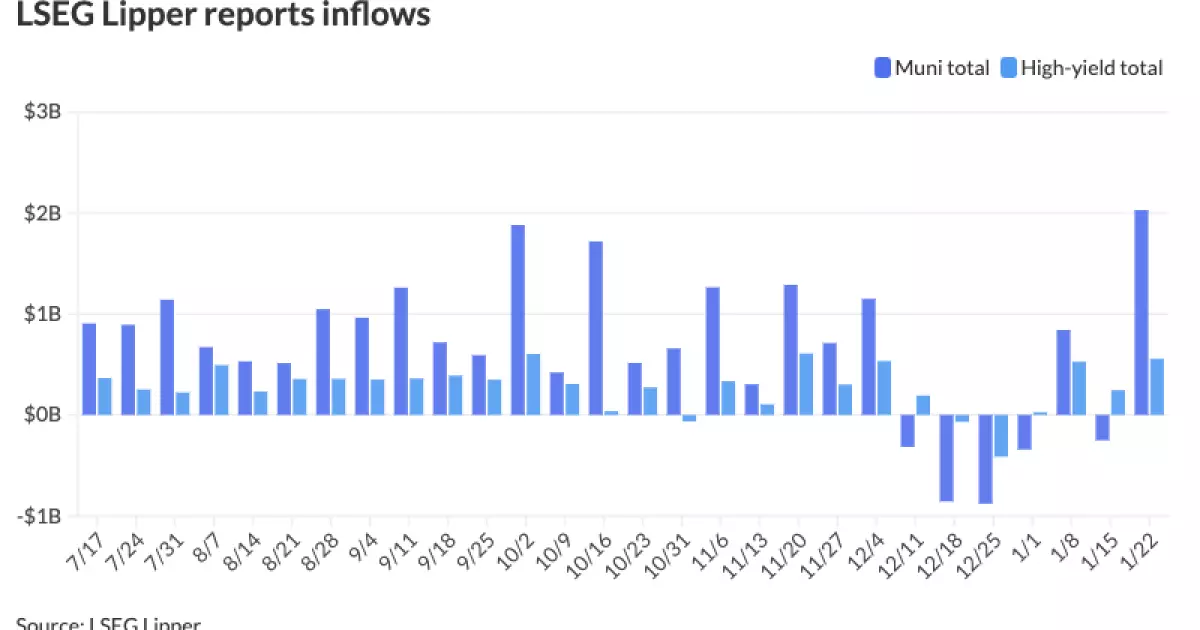On Thursday, the municipal bond market exhibited signs of weakening, characterized by a slowdown in the primary market and impressive inflows into municipal mutual funds that surged past $2 billion. In contrast, yields on U.S. Treasuries rose in the longer-term segments, while the equity markets experienced a mixed finish. The ratios comparing two-year municipal bonds to U.S. Treasuries, alongside five-year, ten-year, and thirty-year sectors, indicated a range between 64% and 83% according to reported data. Notably, municipal bonds continued to thrive amid a complex landscape of supply and demand dynamics, showcasing resilience in the face of adverse conditions.
Kim Olsan, a senior fixed-income portfolio manager at NewSquare Capital, commented on the prevailing market conditions, noting the strong participation from bidders despite an uptick in issuance. This behavior suggested that investors were primarily focusing on yield-generating opportunities rather than the underlying supply-demand fundamentals that typically drive bond market sentiment. Olsan highlighted recent sales, specifically bonds from Washington State and Nevada, which showed narrow spreads in the ten-year maturities—a significant sign of investor confidence when traditionally, such issues are more prone to wider spreads during periods of market weakness.
Olsan emphasized that the current environment presents a rare opportunity for buyers to diversify across multiple high-quality offerings available simultaneously, thereby enhancing competition among them.
The trading landscape has indeed demonstrated instructive patterns that could influence secondary bids moving forward. With several high-rated entities, such as Fairfax County, Virginia, and Mecklenburg County, North Carolina, recording snug spreads relative to AAA benchmarks, the market appears to have a firm underlying support. The pricing of the University of Maryland Medical System bonds further exemplified this trend, where yields moved well below their indicative averages for similar-rated hospital bonds, a testament to strong demand.
Recent secondary trading activity indicated a slight shift, with January’s volumes showing a notable decrease of 30% compared to the previous year’s average. However, this weakness in volume did not translate to a corresponding drift in prices; instead, lower yields have recently bolstered support across various rating categories, reflecting cautious optimism among investors.
January has delivered a mix of financial dynamics in the municipal bond market, with the inflow of $2.028 billion into bond mutual funds being significant, marking the highest inflow since early 2023. In stark contrast, the outflow from tax-exempt municipal money market funds was notable, exceeding $2.74 billion, resulting in total assets of approximately $135.04 billion. This scenario underscores conflicting investor sentiment—while traditional funds saw inflows, higher-yielding sectors experienced a clear reduction in assets.
The early part of the year reflected a preference for mid-tier credits, with the Barclay’s indices revealing differing performance between AAA and single-A ratings. Such observations suggest a potential evolution in investment strategies where investors seek high-yield alternatives outside the conventional high-grade markets, as highlighted by ongoing demand trends across various fund products.
Treasuries demonstrated weakened performance for the longer end, with yields fluctuating across terms. This shift has additional implications as it highlights the broader interest rate environment that, in turn, directly influences municipal pricing and investor strategies. The SIFMA Swap Index, rising two basis points to 2.96%, indicates an environment where investors need to remain analytical about their bond selections, especially given the historical context of yields.
The AAA scales have also shown a marginal cut in response to market activity, yet demonstrated a level of stability that investors can lean upon amid the uncertainty. The ratios reflect a consistent pattern, encouraging a continued observation of yields across different maturities as they relate to overall portfolio management.
The current municipal bond market is navigating through a complex web of factors impacting yields and investor preferences. While headwinds such as rising issuance and wider spreads in less favorable market conditions remain, the robust inflows into municipal mutual funds highlight a sustained interest in high-quality debt. As investors continue to seek out yield opportunities within this fluctuating landscape, the need for close monitoring of market dynamics becomes ever more critical. The interplay of various rating categories, investor sentiment, and ongoing supply issues warrants a prudent approach to portfolio management in the municipal bond arena, hoping to capitalize on emerging opportunities amid the shifting currents.

